Candling Eggs is an easy process that gives you assurance that your eggs are fertile and developing correctly after a short period of time in the incubator. It allows you to remove infertile eggs and soon you will start to be able to identify ‘bad eggs’ and remove these as well. The candling photos on this page should help you to identify these.
Although it has never happened to me, bad eggs can sometimes explode or ooze in the incubator causing bacteria to contaminate the other good eggs, causing them, in turn to go bad.
I usually candle my eggs after a week of incubation. It can of course be done before this but the first week of incubation is the most critical in terms of getting the correct development of the embryo so leaving the eggs alone during this time is good practice. After a week, we are a third of the way through incubation and it is far easier to identify fertile eggs, even if eggs have a dark shell as is the case with Marans.
How to candle eggs
You will need a bright light and a way of shining this through the egg. Candlers can be bought online from poultry shops, or you can make one using a bright light and a cardboard box with a hole cut out for the egg to sit on. Try to get the best seal around the hole and candle in a dark room to see the best results.
Candling Dark Eggs
If the shells are dark or have pigments / marks on them, it can be difficult seeing the embryo. I rock the egg from side to side very gently so the contents move. This must be gentle, or you risk damaging the Chalazae that hold the yolk / developing embryo.
“The Chalazae is the structure that suspends the yolk within the egg. It can be damaged by shocks and vibration”
Remember not to candle for too long if it is heating the egg. I spend around 8 seconds per egg before trying the next one.
What to look for after a week
After 7 days, you should be able to see development of the embryo, including spider like veins and even (if you are lucky) a little movement. The embryo often sits on one side of the egg so be sure to rotate the egg around slowly to get the best view. Occasionally, you may see a tiny heart beating if it is close to the edge of the shell.
Look for fertile and non fertile eggs. Clears as they are called are easy to remove after 7 days. If you have a number of eggs in the incubator, it soon becomes clear which eggs have developed correctly.
By day 7, you should clearly see the embryo. Don’t forget to turn the lights out in the room when you do this so you get a clearer picture!
What to look for after two weeks
After 14 days, the embryo is well developed and turning into a chick. Two thirds of the egg is now covered and it is hard to see any detail.
Look for embryos that have developed so far but died. This can be for a number of reasons, including incubation technique, damage to the chalazae (which can happen when eggs are dropped / damaged in the postal system for example) or become infected with bacteria. A red ring is sometimes seen inside the egg which is the bacterial infection.
The photo to the right shows how much of the egg is now filled with the embryo / soon to be chick. It is more common to see movement inside the shell.
Bad Eggs
If an egg appears bad, it can be removed to prevent it from exploding and contaminating other eggs. Bad eggs can look different every time but if you compare them to the bulk of the other good eggs in the incubator, it won’t be long before you can recognise a bad egg from the rest. The bad egg shown to the right was found at day 14, two weeks into incubation. Clearly comparing this to our last photo, there is a problem.
Bad eggs don’t change – so if you are unsure, mark it and have another look a few days later to see if it still looks the same.
The second photo shows to the right shows the contents of this bad egg after it was opened on a plate. I wouldn’t normally do this because it can be smelly but was worth while to show what the contents looked like, clearly not a nearly developed chick!
There are a few more photos on poultrykeeper’s candling chicken eggs page here.

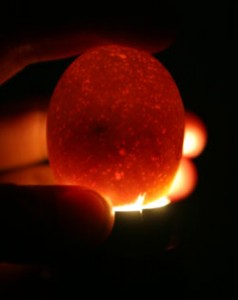
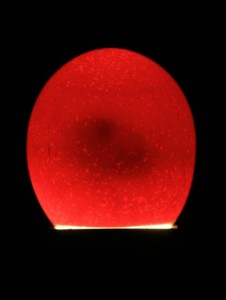
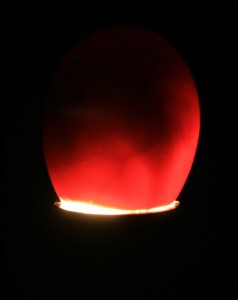
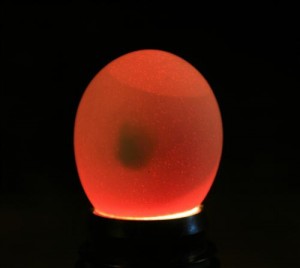
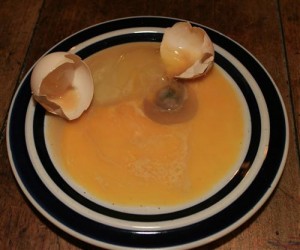



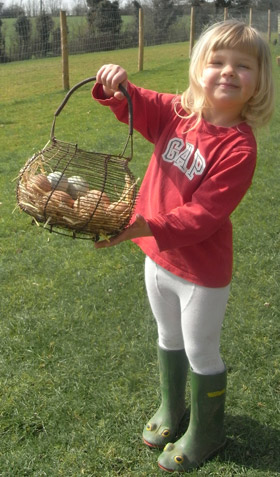

how do I combat soft shelled eggs
There can be a number of reasons for these and some older / hybrid / high production strains (eg ex-batts) often suffer with this because they are very much worn out.
I would check they have oysters shell grit for calcium and no shortage of pellets / mash and greens. Other than that, there are a few other lines of investigation via your vet, disease and calcium absorption for example.
To me i think you should increase the calcium contain of the feed being given to the birds.
I have a homemade incubator, its a black rectangular Tupperware (like the ones you use for takeout) with a heat lamp and a black glass dish filled with water for the humidity. I used dryer lint to make little “nests” for my two eggs, and I turn them 3 times a day. I measure the temperature daily, and adjust the distance from the Tupperware to the beat lamp. it’s day 5, any other tips? thanks!
I haven’t incubated like this but providing the temperature and humidity is right and there is fresh air able to get to the eggs, it should work!
If an egg is completely dark when candled (no air sac) is it safe to assume it is rotten?
It depends on the age of the egg – once a chick develops inside the egg, when you candle it, you can’t see through it so it’s mainly dark with just the air sack clear. Rotten eggs can get dark but with a good flash light and a dark room, you should still be able to see into it fairly well.
Oh and if there’s no air sack (unusual) perhaps it has ruptured and filled with yuk – so be careful it doesn’t explode. Tapping it on something will cause these ‘bangers’ to explode making a huge mess – I had a goose egg do this and cover my face and believe me, you won’t ever want that to happen 😉
hi, I found a robin egg on the ground and could not find the nest or the mom, (I kept some distance for 10 minutes just to make sure she wouldn’t come back) so, I took the egg.(when I picked it up it was still warm) We have been incubating it and one day I candled it and all i could see was an air sack at the smaller end of the egg, a black dot that moves as if it was a bubble, but I am sad to say that there were no spidery veins that I could see. Do I need a brighter flashlight to be able to see the veins? Do you think that it is still alive? (I don’t know how far along the bird is, but we have been incubating it for almost three days) I also took the water test, ( where you put the egg in warm water and if it floats just under the surface it is supposedly alive ) and it was a low floater, which is suppose to mean that the egg is still viable. If you can give me any information on what I should do and if it is still alive, please please please write back!
Personally, I would say mother nature should take its course… if it hatched, would you have the right food to raise it? It would need feeding all through the day – the Robins work hard feeding their young! Assuming you could raise it, it would become very tame and be an easy target for a cat as well.
To answer your questions though, I don’t have experience of candling this sort of egg – if you can see through though, you should be able to see development after 3-4 days because the incubation time will be much less for a smaller egg. My guess is the Robin realised this one wasn’t viable and pushed it out of the nest.
When breeding naturally by using a broody hen, does she regulate the humidity by the way she sits on the eggs and turns them or do we need to assist in any way?
Yes, she’s clever and takes care of it all. During hot weather they will sit up above the eggs slightly and lift herself up to let fresh air around the eggs from time to time.
to me i think she do regulate the humidity in that you will bear with me that a bird or a mother hen can not remain on top of the eggs for the whole day so any time she moves out they eggs then receive a little bit of air which regulate the temperature.